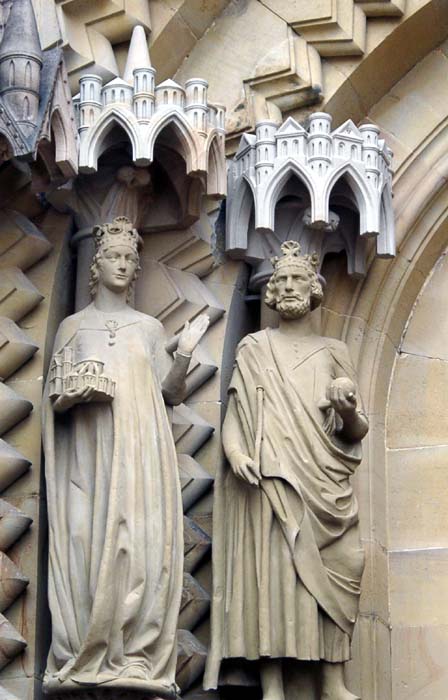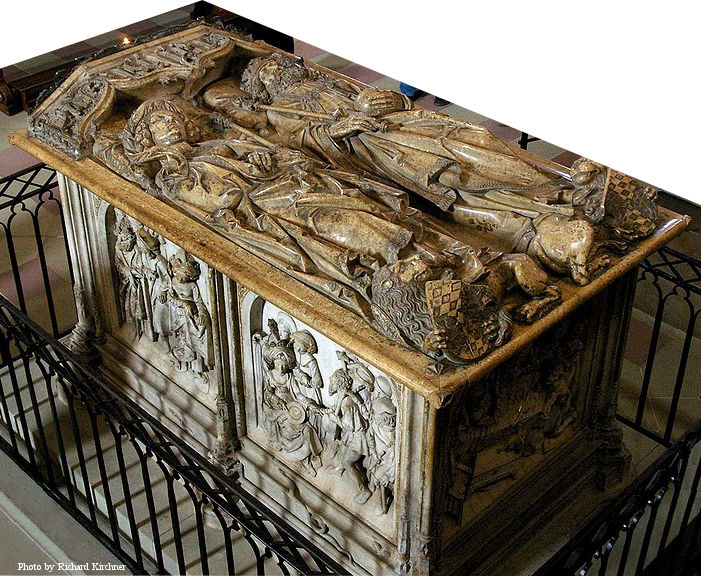(c. 975 – 3 March 1040 at Kaufungen), also called Cunegundes and Cunegonda

Statues of Saint Cunigunde of Luxembourg and her husband, St. Henry II, at the Cathedral of Bamberg, Germany.
ST. CUNEGUNDES was the daughter of Sigefride, the first count of Luxemburgh, and Hadeswige his pious wife. They instilled into her from her cradle the most tender sentiments of piety, and married her to St. Henry, duke of Bavaria, who, upon the death of the emperor Otho III. was chosen king of the Romans and crowned at Mentz on the 6th of June, 1002. She was crowned at Paderborn on St. Laurence’s day, on which occasion she made great presents to the churches of that city. In the year 1014 she went with her husband to Rome, and received the imperial crown with him from the hands of Pope Benedict VIII. She had, by St. Henry’s consent before her marriage, made a vow of virginity. Calumniators afterwards accused her to him of freedoms with other men. The holy empress, to remove the scandal of such a slander, trusting in God the protector of innocence, in proof of hers, walked over red hot plough-shares without being hurt. The emperor condemned his too scrupulous fears and credulity, and made her ample amends. They lived from that time in the strictest union of hearts, conspiring to promote in everything God’s honour, and the advancement of piety.
Going once to make a retreat in Hesse, she fell dangerously ill, and made a vow to found a monastery, if she recovered, in a place then called Capungen, now Kaffungen, near Cassel, in the diocess of Paderborn, which she executed in a stately manner, and gave it to nuns of the Order of St. Benedict. Before it was finished St. Henry died, in 1024. She earnestly recommended his soul to the prayers of others, especially to her dear nuns, and expressed her longing desire of joining them. She had already exhausted her treasures and her patrimony in founding bishoprics and monasteries, and in relieving the poor.  Whatever was rich or magnificent she thought better suited churches than her palace. She had therefore little now left to give. But still thirsting to embrace perfect evangelical poverty, and to renounce all to serve God without obstacle, on the anniversary day of her husband’s death, 1025, she assembled a great number of prelates to the dedication of her church of Kaffungen; and after the gospel was sung at mass, offered on the altar a piece of the true cross, and then put off her imperial robes, and clothed herself with a poor habit: her hair was cut off, and the bishop put on her a veil, and a ring as the pledge of her fidelity to her heavenly spouse. After she was consecrated to God in religion, she seemed entirely to forget that she had been empress, and behaved as the last in the house, being persuaded that she was so before God. She feared nothing more than whatever could bring to her mind the remembrance of her former dignity. She prayed and read much, worked with her hands, abhorred the least appearance of worldly nicety, and took a singular pleasure in visiting and comforting the sick. Thus she passed the fifteen last years of her life, never suffering the least preference to be given her above any one in the community.
Whatever was rich or magnificent she thought better suited churches than her palace. She had therefore little now left to give. But still thirsting to embrace perfect evangelical poverty, and to renounce all to serve God without obstacle, on the anniversary day of her husband’s death, 1025, she assembled a great number of prelates to the dedication of her church of Kaffungen; and after the gospel was sung at mass, offered on the altar a piece of the true cross, and then put off her imperial robes, and clothed herself with a poor habit: her hair was cut off, and the bishop put on her a veil, and a ring as the pledge of her fidelity to her heavenly spouse. After she was consecrated to God in religion, she seemed entirely to forget that she had been empress, and behaved as the last in the house, being persuaded that she was so before God. She feared nothing more than whatever could bring to her mind the remembrance of her former dignity. She prayed and read much, worked with her hands, abhorred the least appearance of worldly nicety, and took a singular pleasure in visiting and comforting the sick. Thus she passed the fifteen last years of her life, never suffering the least preference to be given her above any one in the community.
Her mortifications at length reduced her to a very weak condition, and brought on her last sickness. Her monastery and the whole city of Cassel were grievously afflicted at the thought of their approaching loss; she alone appeared without concern, lying on a coarse hair-cloth, ready to give up the ghost, whilst the prayers of the agonizing were read by her side. Perceiving they were preparing a cloth fringed with gold to cover her corpse after her death, she changed colour and ordered it to be taken away; nor could she be at rest till she was promised she should be buried as a poor religious in her habit. She died on the 3rd of March, 1040. Her body was carried to Bamberg, and buried near that of her husband. The greater part of her relics still remain in the same church. She was solemnly canonized by Innocent III. in 1200. The author of her life relates many miracles wrought at her tomb, or by the intercession of this holy virgin and widow.

The tomb for St. Henry II., Holy Roman Emperor, and his wife St. Cunigunde of Luxemburg in the Cathedral of Bamberg, created in 1499-1513 by Tilman Riemenschneider.
From her life, written by a canon of Bamberg, about the year 1152: also the Dissertation of Henschenius, p. 267.
cfr. The Lives of the Saints, by Rev. Alban Butler, 1866. Volume III: March, p. 501-502.










